



Way back in 1995, the artist collective Critical Art Ensemble (CAE), said “What your data body says about you is more real than what you say about yourself. The data body is the body by which you are judged in society, and the body which dictates your status in the world.” These words now haunt us, and take their place alongside numerous other ignored warnings about global threats to the wellbeing of our societies and the planet.
In this interview with curator Dani Admiss, we discuss how the data-driven gamification of life and everything has shaped the development of Playbour – Work, Pleasure, Survival at Furtherfield and why the Gallery is currently being transformed into a psychological environment.
Gallery visitors are presented with a series of game-like installations, which are the result of the shared and collective cognitive labour of artists, curators and gallery staff. First the artists, and then the public (as players) are invited to test the processes and experiences offered by new mechanisms of play and labour. Each ‘game’ simulates an experience of how some techniques and technologies of gamification, automation, and surveillance, are at work in our everyday lives, in order to capture all forms of existence.
Marc Garrett: Before the exhibition, you initiated an open call for a Lab. You invited participants to join a three-day art and research lab at Furtherfield Commons, Finsbury Park, London. Could you elaborate why you did this and how it informed the exhibition?
Dani Admiss: A couple of months before the exhibition, I ran a 3 day co-research lab that brought together artists, designers, activists, and researchers. I like to refer to it as a performative, temporary exhibition in the form of a lab. There were discussions, performances, interventions, games, and exercises. We had discussion with Jamie Woodcock on gaming and digital labour, he walked us through an interview session with gamers on the Twitch platform. Steven Levon Ounanian held a performative experiment where we thought about how we might render the suffering online in the real world, Itai Palti worked with us to think about design principles and neuroscience. FUN! The idea was that we would collectively explore, discuss and define key issues that we thought were important to then take forward to develop into games and experiences to share with the public. The aim was to play off each other in a live context to generate new perspectives and ideas.
Building on this, I decided to hold an open call for participants. In my most idealistic moment, I’d say I wanted to try and find ways to expand who gets to produce, stage and display, how we define what these issues actually are for wider audiences. Can this lead to new stories about art, tech, society? Like any project it is never exactly as you imagined it, but I think the majority of people got a lot out of working like this. I did. Working with people that aren’t always the people you expect to be attached to a project always throws up unexpected experiences. Everyone brought their best themselves with them. Open. Interested. Warm. Prepared. Ready to listen, and for fun!
I’d make the lab longer next time, so it wasn’t as intense, and I’d try to have more people join the open call.
MG: The open-curation process you have developed is core to the realisation of the Playbour lab and exhibition. It resonates strongly with Furtherfield’s DIWO ethos. It turns on its head, the traditional approach to curating thematic group shows. Please can you tell us about the process and say why this new approach is important at this time?
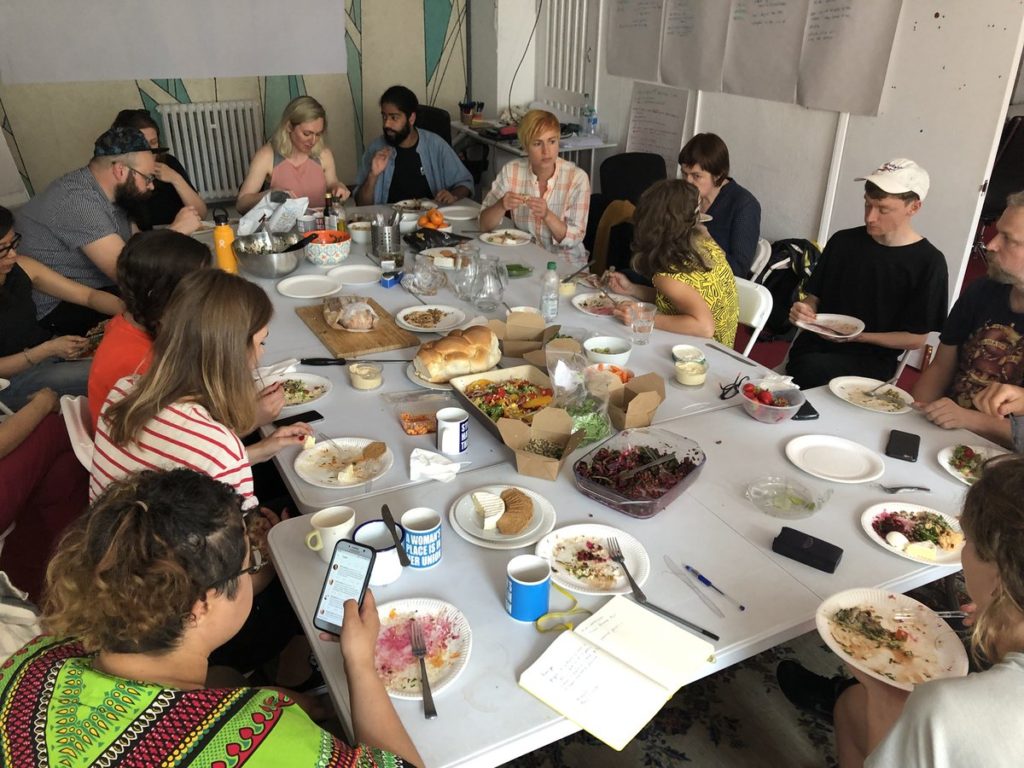
DA: DIWO definitely informed Playbour! I think the spirit of co-creative discovery is a powerful tool that curators should use more. I refer to it as co-research, which is ultimately a way to research-with others. What separates it from more traditional approaches to curating is the unclear distinction between author/researcher and subject/participant. The aim is to achieve closer equality between the participant and subject area, in the form of valuing a person’s idea’s and lived-experience as much as other ‘expert’ forms of knowledge. Historically, it has roots in a highly specific context of the radical Left in post-war Italy with Operaismo. This is where the seeds of debate on post-immaterial labour emerged, arising from Hardt, Negri, Bifo, Terranova, etc, and why I originally was interested in working in this way because of the subject matter of the project, however, it became something so much more.
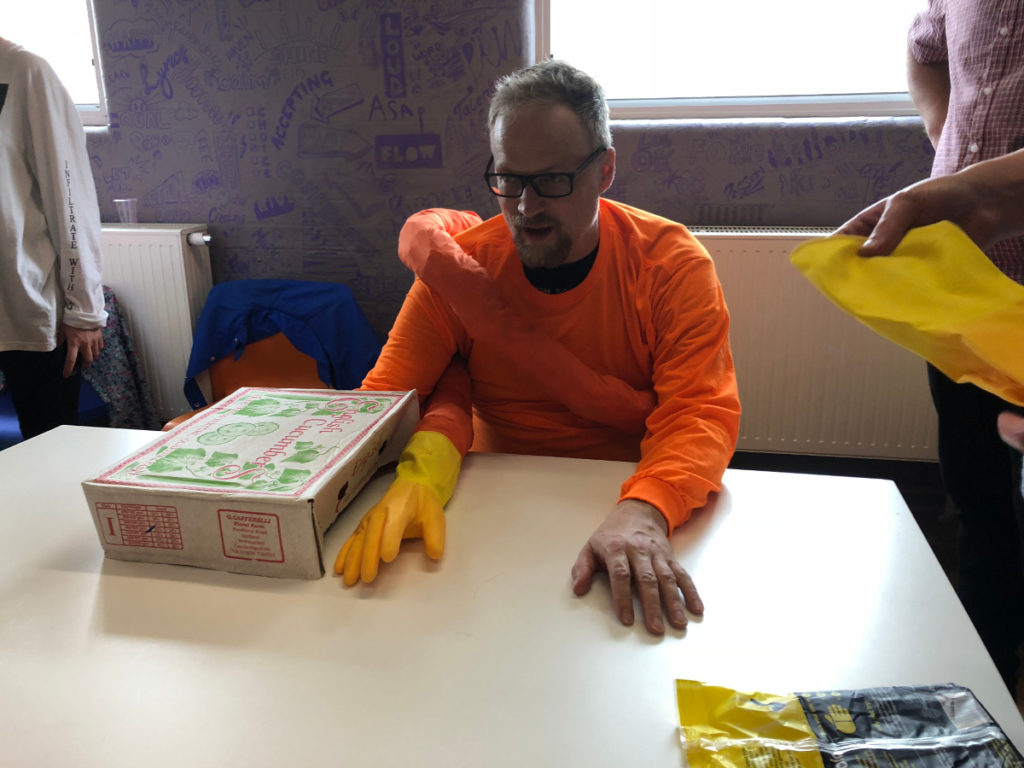
For me, as a curator, creating projects about complex subject areas that bring together embodied and embedded social relations with technical worlds, is something that needs to be done with people rather than to them. I think the most interesting works of art being produced today are treated less like things and instead draw into the very making of the ways in which we get to know what we know. You can see this in works from Cassie Thornton’s project Collective Psychic Architecture (an exploration of “bad support” in Sick Times) 2018, where she extends the responsibilities of the gallery or institution through performative means, or in the high-profile modeling and mapping practices coming out of the Forensic Architecture network. How can curating exist in a wider space than before? I’m trying to work in much more extended and expanded ways with the primary intention to include more end users into the areas we are looking at.
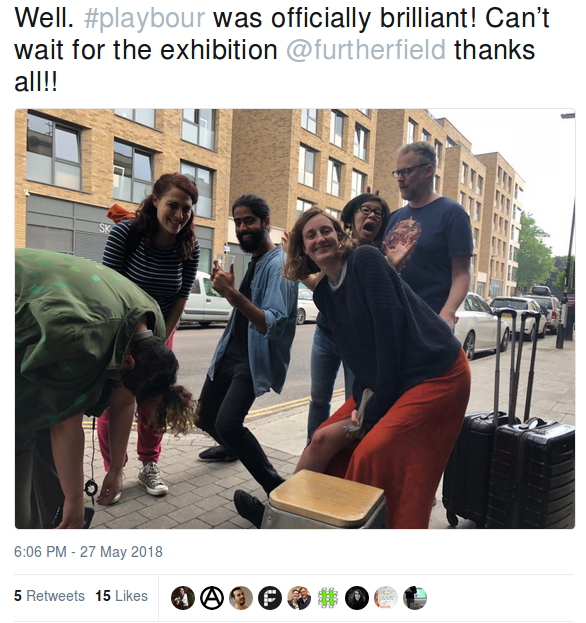
Adopting a co-research model (in the lab, in the show, in the publication, in the micro-commissions) meant that the aim of the exhibition shifts, it becomes less about what the topic is and how it works and more about how it came to be. Brian Holmes once wrote that making an image remakes the world. Yes, but it also distances us from it. Playbour asks people to consider how the world organises us by facilitating moments where people can identify with particular phenomena. I feel this is more fitting and has more potential to create moments of personal learning and change than trying to represent it through curatorial practice. Why do we need this in an age of information? My thinking is that knowledge-projects are not simply objective processes but deeply subjective ones that are enacted through and with others. Finding ways for people to identify in more meaningful ways with the subject will hopefully lead to greater chance that people will gain greater perspective and agency over their own worlds.
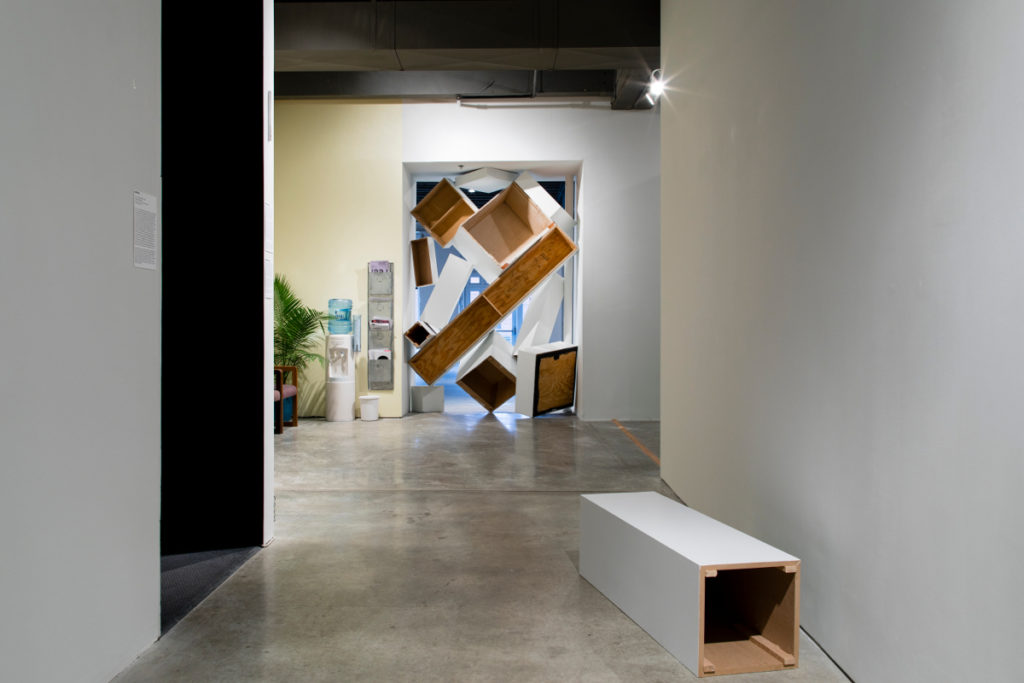
MG: The term Playbour brings attention to critiques of gamification and to the extraction of value via social media platforms. But your subtitle then opens up a whole other world of reflection. What are you discovering about the relationship between “work, pleasure and survival”?
DA: The project is exploring the role of the worker in the age of data technologies, but this looks less at the “future of work” and chooses instead to focus on the shifting roles and blurred boundaries of work, play and well-being – how do we place value on these areas, how do we work with and against them?
Quite often when we talk about opaque terms like immaterial labour and cognitive capitalism we fail to grasp the production processes of these phenomena. Immaterial labour depends on the self and our social relations. We are asked to ‘post’, ‘share’, ‘network’, ‘emote’, ‘communicate’, ‘know’. Not so much ‘understand’. These acts inform the control and creation of our subjectivity. At the same time, very little discussion is happening about the fact that so much exploitation -physical, ecological, economical- sits behind the new commons we are all talking about.
Opening the project out to think about work, pleasure, survival, is a provocation. On one level, it is a nod to the fact that this conversation is for a privileged few. Many choose what they do and this ‘choice’ is supposed to operate as an expression of one’s personality. On the other, it’s human nature to get swept up in what is considered the norm, so it’s also a challenge to think about what are your own limits, returning to the idea of inviting people to find moments of identification with these broader issues to their own lived experience.
MG: Why is it important that the work being prepared for Furtherfield gallery is conceived of more, as a series of game experiences, than a display of discrete art objects, or a didactic exhibition on the topic of Play and Labour? Has the gallery’s location in a public park influenced your thinking at all?
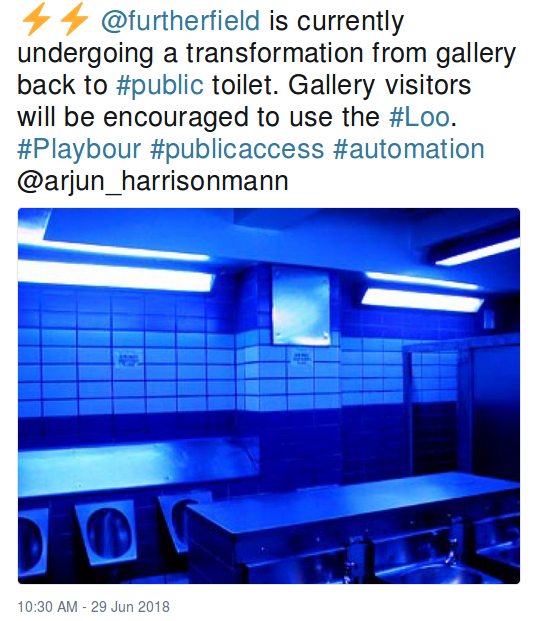
DA: Well, first off, it has been a collective process and so I wanted to show that process to people. Secondly, you have to invest part of yourself in play. The more I research the areas of digital and immaterial labour the more I’m keen to work with others to understand the not yet completed transformations of body, society, and world, into a global capitalist system. These are suffuse and pervasive and nudge our behaviours all of the time. Organising the exhibition as experiences is a way for us all to live-out (at least temporarily and in a safe, playful space) the tentacular effects of immaterial labour and economies of knowledge and information. This is not to say let’s walk away from a highly networked society, it’s an invitation back into perspectival agency.
MG: You’ve chosen to put together three themes for the exhibition, ranging across work, pleasure, and survival. Why was it important to choose these three themes in particular?
DA: I’m fascinated by how we are involved in the making of worlds we are then conditioned by. From the learnings in the lab, my own research and collaborations leading up to Playbour, I think gamification, automation, and surveillance are three key areas that scaffold a lot of the debate on digital and immaterial labour.
1) SURVEILLANCE. How we are measured and how we measure ourselves? Traditionally, government control used to come from top-down surveillance techniques, such as the type Michael Straeubig’s Hostile Environment Facility Training (HEFT) is looking at. However, I think we should be talking about how forms of control are exercised through our own self-monitoring processes – self-improvement culture is a perfect example of this. Cassie Thornton’s Feminist Economics Yoga (FEY), is a wonderful remedy for this.
2) AUTOMATION. How technology is removing decision-making from us in the pursuit of a frictionless universe. In Harrison-Mann’s Public Toilet he is talking about how automation is used to address the need of social issues. The starting point is the lack of public services offered in Finsbury Park and how that is altering how we use and experience the public space of the park. He is interested in making a connection between this and how metrics can often end up being exercised in controversial and even arbitrary ways inhibiting people getting what they need, such as disability benefits in the UK.
3) GAMIFICATION. How are rewards and competition embedded into our online interactions and interfaces? Jamie Woodcock has this excellent term that describes gamification-from-above and gamification-from-below. Like the Situationist socialism-from-below. How we might use gamification for our own positive manipulations, diversions and distractions? I think a lot of media and new media practice has long been engaged in gamification-from-below. Marija Bozinovska Jones’ piece Treebour (201) plays on this, transferring manipulation of social relations levelled at online interactions to the “natural” networking of trees.
MG: After visitors have experienced the exhibition, what emotions, thoughts and understandings, would you like them to leave with?
I think you introduced the show in an interesting way in your opening text with the notion of the data body and the extension of our bodies into new spaces with unknown consequences. These happen inside the screen, at the edges of the world, in transit, at the end of the supply chains. At the same time, they also operate on semi-conscious refrains, in our behaviours, actions, thoughts and emotions about the world. Taking part, thinking-with, making-with, are strategies to find ways to open up discussions about how we are all involved in making and unmaking our worlds via different actions. Something like digital and immaterial labour is not a discrete issue reservable for experts who work in this area, the connections and consequences weave in and out of our lives and impact us all. We are constantly reacting to thing around us, taking in these cues and pushing them back out into the world.
In terms of emotions, I don’t want to spread fear and despair, I’m hoping that some visitors will identify with some of the ideas in the show and relate them to something in their life that perhaps they’d not thought of in that way before.
Notes: Main top image by Marija Bozinovska Jones, Treebour 2018.
DIWO – Do It With Others: Resource
archive.furtherfield.org/projects/diwo-do-it-others-resource
In her work, using video, performance and the Internet, Annie Abrahams questions the possibilities and the limits of communication, specifically its modes under networked conditions. A highly regarded pioneer of networked performance art, Abrahams brings her academic training in both biology and fine arts to develop what she calls an aesthetics of trust and attention. She creates situations that “reveal messy and sloppy sides of human behaviour” making that reality of exchanges available for reflection. We first worked with Abrahams in her exhibition ‘If not you not me’ in 2010 and then as part of a group show ‘Being Social’ 2012. In this interview we ask her to reflect on the limits and potentials of art and human agency in the context of increased global automation.
Catlow & Garrett: While predicated on the idea of connectedness, the global social media platforms are designed to profit the companies who create them and to keep billions of us in a state of trance-like immersion which has in turn been shown to cause many of us to feel more isolated. At Furtherfield we have always worked to grow more communal and collaborative contexts for artistic production. What does your current thinking – through your work on Participative Ethology in Artificial Environments: ethnological approaches to Agency Art – reveal for the potential of genuine, participatory networking environments?
Annie Abrahams: Participative Ethology in Artificial Environments: ethnological approaches to Agency Art sounds nice, but it needs a question mark at the end. It’s an interrogation. In times when our technological environment uses all kinds of behavioural techniques to make us uncritical users of their interfaces, it’s important to become aware of our behaviour, to test and experiment with it. My artistic work is based on doing that, but I always had great difficulties explaining it to art institutions etc.
A discussion I had with my friend Cor whom I studied biology with in the seventies, helped me find this latest description. I told her, that I think about my work as having human behaviour as its main aesthetic component and why I call it, silently, “behavioural art”. I compare what I do now to what I did when I studied biology. In both cases I observe behaviour in constrained situations. The monkeys, that were the study objects “became” humans and the cage the Internet.

Because the behavioural science of the late seventies didn’t suit me very well – using Skinner boxes, operant conditioning techniques and related to sociobiology, with a link to eugenics – it has become impossible to use this historically contaminated term. The wish to control, mold nature, and humans wasn’t mine. “Behavioural” was and still is a “stained” word for me. But even so, I do study behaviour and create constrained situations. I ask people to perform in a frame, they are framed in an apparatus, which is more or less perfect – the Internet provokes, lags, bugs, glitches, the computer is old or new, fast or slow, the interface determines how the performers can interact or not, the domestic situation interferes with noise and cats wanting to join in. There is a protocol/a script/a scenario but no rehearsal, just some technical tests. My approach is more phenomenological than scientific, I don’t measure anything. It’s up to the performers to explore their own behaviour, to reflect on it and to learn together what it means to be connected.
I told Cor, my annoyance with the tendency of art institutions to categorise art. Video art, poetry, contemporary art, literature, dance, painting, music and media art, computer art, code art, … It’s so impractical and superficial and it always takes a technology or a medium as its anchor point. It doesn’t say anything about what it makes possible, about what we can experience through it. Maybe that’s why I started to use the word performance, and performance art more and more. It’s a cross-discipline word. It’s multi purpose, but also a bit empty, I must admit.

“Agency Art is art that makes it clear to the receiver via his or her body what is at stake, where opportunities for action lie, and which virtual behaviours he or she can actualize. It demonstrates how choices work.” Arjen Mulder, The Beauty of Agency Art, 2012.
In his article The Beauty of Agency Art, Arjen Mulder uses the concept Agency Art to indicate interactivity as the important component of an art work. It is an interesting attempt to develop a discourse for technology/media art in relation to the contemporary art discourse. He embeds his ideas in history and goes back to thinkers such as: Shannon, Wiener, MacKay, McLuhan, Cassirer, Langer, Gell, Latour, Heidegger, Derrida, Badiou, Rancière, Danto, Whitehead, Steiner, Rolnik and more. I like the concept because it determines art that has behavioural choices and gestures as its centre. Its meaning is the acts that are made possible. What is also important in Mulder’s reasoning, is the concept of “virtual feeling”, introduced by the philosopher Susanne K. Langer in her groundbreaking book Feeling and Form (1953). Langer explains how each individual art medium evokes, manipulates and investigates “virtual feelings” in its own way.
“A painting calls forth virtual depth with lines and colours; a sculpture constructs a virtual volume around itself; a novel constitutes virtual memory, tracked through virtual time. Dance follows virtual forces of attraction and repulsion. All the experiences that are part of this “feeling” are spaces of possibility, virtual feelings waiting for actualization; their nature, allurements and dangers must be studied, and art is where this investigation takes place” Arjen Mulder, The Beauty of Agency Art, 2012.
This is how to think of behaviour as an aesthetic force, I told Cor. This is a concept that I can use to talk about what is important to me. For me, the words are empowering and stimulating, pointing to Butler, ANT theory and Karen Barad, I cannot and won’t leave them behind me.
collectively made – refusing hierarchy- a knitting together of artists and performers in the moment of the event – erasure of the artistic ego – practice – changing rules – choices – connecting – accepting the unexpected – responsive – shared – collaboratively authored – open to all – working with temporal behavioural phenomena – healing – enactment – improvised – including environmental conditions – attentional strategies – instructions – protocols – apparatus – meeting – embracing the ordinary – rehearsing alternatives – re-hijacking therapy – exercising our relations to others – our social (in)capacities – exploring rituals – being together – participatory – concerns individuals and politics
These are keywords found while researching work (from fine art, dance, theater, music, performance, digital art to electronic poetry) I could consider being Agency Art : Deufert&Plischke’s work, LaBeouf, Rönkkö & Turner’s HEWILLNOTDIVIDE.US, Building Conversation by Lotte van den Berg, Deep listening by Pauline Oliveros, Poietic Generator by Olivier Auber, Lingua Ignota by Samantha Gorman and Walking Practices by Lenke Kastelein.
Using Agency Art also means being able to make cross sections through disciplines and to open up closed domains of practicing. And that is the moment in our conversation where Cor, who has also a degree in philosophy said : “It’s easy, call your work participative ethology in artificial environments.” I am still pondering and that’s why there has to be a question mark. There always have to be question marks.
#PEAE = #Participative #ethology in #artificial environments #ethnological approach #AgencyArt?
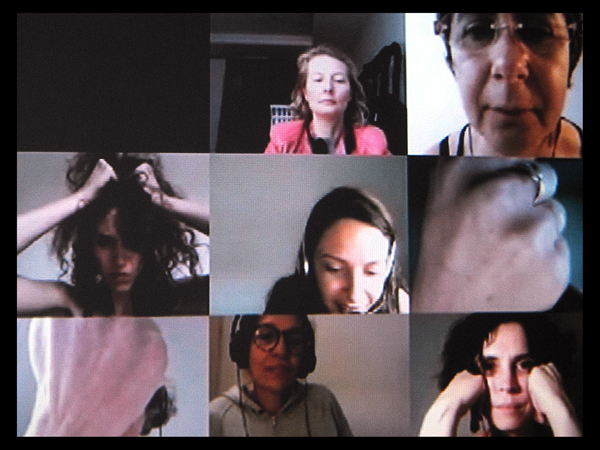
C&G: Katriona Beales drew our attention to the Kazys Varnelis’ essay in the Dispersion catalogue (ICA 2008) which talks about the concentration of power in nodes of connectedness. She says “So even if I write a response to Donald Trump’s tweet saying “I hope you’re impeached”, for example, I add to his power, just through the interaction. I end up contributing to his power base even though I explicitly disagree” This effectively rewards, with attention, those who inspire intense outrage, fury and derision. Interfaces play a crucial role in your network performances and deliberately prompt very different kinds of behaviour – we’re thinking in particular of Angry Women. What kinds of behaviours and responses does your work inspire?
AA: I agree the concentration of power in nodes of connectedness is disturbing and confusing. It puts us in a double bind situation, becoming petrified, unable to act or to flee because we can not choose. I think this might be true when we consider our role in big networks, but it is definitely different when we talk about smaller networks. There it matters what we say and especially how we say it. A big part of my work is to create situations / interfaces / performances that permit us to experiment and train our (un)capacities to do so in networked environments. Participating in one of my performances means taking risks – nothing is rehearsed, means accepting you can’t control everything, it means committing to continue even if all seems to go wrong, to be attentive to the others around you with whom you share the performance space, with whom you are co-responsible for the shared moment in time.
From the people watching I ask that they are aware of what is at stake in a performance. That they watch it not with a connoisseurs regard, but that they see it as an aesthetic experiment in which behaviour is the main aspect / asset. If they become sensitive they have access to a very intimate and fragile aspect of our being, to something we absolutely need to discover further if we want to escape an allover binary future.
For myself I analyse the “concentration of power in nodes” phenomenon as the result of something you could call a lack of res-ponsability in our online affect management. When you are always scrolling you are unaware of the reaction you provoke, you are not awaiting a reply, but already on the next, next, next photo or short text. There is very little interactivity, and even less exchange. We act without caring for what our words, actions, and ideas bring forth. We might not be aware but our words, actions, and ideas live beyond us, they do intra-act with the actual situation. They are things acting in a world. (**)
** I have been reading texts on intra activity, a neologism introduced by the physicist, and feminist theorist Karen Barad. It’s difficult stuff. This video (Written & Created by: Stacey Kerr, Erin Adams, & Beth Pittard) gives easy access to one of her most important points.
C&G:
Yes, it is now totally normal to refer to “people” as “consumers”, every organisation an “enterprise”, which in turn leads to proposals for the nation-as-a-service, populated and run in the interest of private enterprise as offered by the e-stonia bitnation project.
By accepting the impoverishment of experience and reduction in agency implied by this label we can forget about ourselves as “actors” in the world, and become the cattle of the few. The only agency we are offered is as a responsible consumer (in which our powers are reduced to a binary option to buy or not). This is the new democracy.
In the UK these days, art audiences are often described as “consumers”. How else in your view might we conceive of “audiences”. What agency might we wish for them. And what part might our relationship with devices and digital networks play in this new description?
AA: We are not yet used to machines reacting to and using affects, tapping into our endocrine system. Articles like “Our minds can be hijacked’: the tech insiders who fear a smartphone dystopia” make us more and more aware of how we are manipulated and distracted, how our attention is designed, guided, influenced, used. But a lot of it is still hidden and because it’s so rewarding and because we “need” the attention we continue to click and vote. It is possible to create environments where people can slow down and have more subtle, nuanced agency, where they can participate and become aware and reflect on of their own behaviour. DIWO projects for instance have that power. People, especially art lovers, can be challenged to engage with others in interesting actions and conversations.
With Daniel Pinheiro and Lisa Parra in Distant Feeling(s) we invited the audience to join us in an experiment where we share an interface, normally used for online conferencing, with our eyes closed and no talking allowed. It led to very diverse observations shared via social media and email exchanges: liminal space – pure motion – an intimate regard – a field of light – dissolved, destabilized – an altered state – a telematic embrace – a silent small reprieve – hanging out with friends – machines conversing across the network only when the noisy humans finally shut up – an organic acceptance of silence?
Keywords from the reactions : http://bram.org/distantF/
Distant FeelingS #3 | VisionS in the Nunnery – Oct5-Dec18 2016
C&G: Unlike technologies and forms of production that work in the area of speculative realism, automation and AI, you still place humans and human relations at the centre, how do you view the current moves to shift agency away from humans into these ranges of techno-social systems?
AA: I am particularly intrigued and troubled by what is called deep learning. The algorithms produced by the machines themselves have a big influence in and, we must be honest, potential for for instance the health care business. They also determine on what moment of the day, depending on your mood you will see which advertisement on your device. As explained in The Dark Secret at the Heart of AI nobody can really understand how these applets produce their outcome – not even the programmers who build them.
For me this is problematic. Algorithms cannot invent what didn’t exist before and so they tend to reproduce / to select more of the same / to reinforce the existent. (see deep dream images) Moreover a lot of deep learning is based on the algorithm learning to produce a desired outcome.
As the machines are also designed to make us ready for their coercion, we are already subconsciously, intuitively adapting to these black box processes. We need to try to understand how these processes influence us, not because they are necessarily bad, but because our interests might not always coincide, we might want to differ. We don’t all have to learn programming the machines. That has become far too complicated and specialist and maybe not the best route to take. But we could engage in projects who try to find out how to influence machine behaviour, how to keep some agency. Maybe by introducing noise and entropy into the processing, so, together with the machines we can continue to cherish difference and diversity.
C&G: This question connects with the previous one. How do you see the role of artists in finding ways to negotiate a healthy relationship between artistic agency and capital-driven-machine worlds?
AA: This is a very difficult question to which every artist has to formulate her own answer. But it for sure passes by trying to open up spaces and discussions with people who have other opinions than yours, to going beyond safety-zones, to finding ways to communicate with and about hatred, angst and love.
*——————–*
This editorial series, takes digital addiction as its theme, and sits alongside the Are We All Addicts Now? exhibition, book, symposium and event series, we are hosting at Furtherfield. Are We All Addicts Now? Is an artist research project led by Katriona Beales and has been developed in collaboration with artist-curator Fiona MacDonald: Feral Practice, clinical psychiatrist Dr Henrietta Bowden-Jones, and curator Vanessa Bartlett. It looks at the application and impacts of many different research findings in the creation of digital interfaces, devices and experiences under the conditions of Neoliberalism.
Economic theory states that technological change comes in waves: one innovation rapidly triggers another, launching the disruptions from which new industries, workplaces and jobs are born. Steam power set in motion the industrial revolution, and likewise since the 1990s a torrent of digital and software developments have transformed industries and our working lives. But the revolutionary very quickly becomes humdrum, and once-radical and efficient innovations like the telephone, email, smartphones and Skype, become part of everyday, even mundane experience. Despite all the time-saving devices we have successfully integrated into our lives, there is a collective anxiety about the current wave of technological change and what more the future holds. Mainstream dystopian visions of our relationship with technology abound, but are we in fact engaged in a group act of cognitive dissonance: using our smartphones to read and worry about robots taking over our jobs, whilst wishing for a shorter work week and more time for creative pursuits?
The British Academy recently brought together a panel of experts in robotics, economics, retail and sociology to talk about how technology is reshaping our working lives. This review summarises some of their thoughts on the situation now, and what developments lie ahead. Watch the full debate here.
Helen Dickinson OBE reported on the British Retail Consortium’s project, Retail 2020, a practical example of how technology is changing consumer behavior and affecting firms in her industry. The UK’s retail sector has on the one hand embraced technology and created a success story. The UK has the highest ecommerce spend per head in the developed world, with c15% of transactions taking place online, and at 3.0m employees it is also the largest private sector employer in the UK. However, beneath this, internet price comparison ushered in fierce price competition. Retailers are using technology to improve manufacturing and logistic efficiencies to control costs and offset shrinking profit margins. Physical stores are closing as sales migrate online. The BRC predicts a net 900,000 jobs will be lost by 2025. Nor will the expected impact be even: deprived regions are more reliant on retail employers and so will be more affected by job losses. Likewise, the most vulnerable, with less education or skills and looking for work in their local area, will be the hardest hit.
Prof Judy Wajcman resisted the urge to overly rejoice or despair at technological developments. For her, this revolution is not so different to the waves which have come before. It is impossible to predict what new needs, wants, skills and jobs will be created by technological advances. Undoubtedly some jobs will be eliminated, others changed, and some created. However, we can certainly think beyond the immediate like-for-like: a washing machine saves labour, but it has also changed our cultural sense of what it means to be clean. Critically, we should stop thinking of technology as any kind of neutral, inevitable, unstoppable force. All technology is manmade and political, reflecting the values, biases and cultures of those creating it. As Wajcman said, ‘if we can put a man on the moon, why are women still doing so much washing?’ In other words, female subjugation to domestic labour could have been eliminated by technology, but persistent cultural norms have prevented this from happening.


Dr Sabine Hauert is a self-professed technological optimist. For her technology has the potential to make us safer and empower us, for example by reducing road accidents, or allowing those who cannot currently drive to do so. Hauert sees a future not where robots completely replace humans, but where collaborative robots work alongside them to help with specific tasks. The crucial issue for dealing with this future lies in communication and education about new technologies, since the general public, mainly informed by news and cultural media, is ill-served by a steady drip of negative stories about our future with robots.
The short film Humans Need not Apply is one such alarming production, chiming with Dr Daniel Susskind’s altogether more gloomy view of the longer term effects of technological advances on the workforce. To date, manufacturing jobs have been those most affected by automation, but traditionally white collar jobs also contain many repetitive tasks and activities (just ask the employee drumming their fingers on the photocopier). Computing advances mean that many more of these are now in scope for automation, such as the Japanese insurer replacing some underwriters with artificial intelligence. For Susskind, it is not certain that workers will continue to benefit from increased efficiencies as technology advances. A human uses a satnav provided s/he is still needed to drive, but the same satnav could just as easily interface with a self-driving car, eliminating the need for any kind of human-machine interaction. Calling to mind the wholesale changes to UK heavy industry in the 1980s, any redeployment of labour will present huge challenges, and what work eventually remains may not be enough to keep large populations in well paid, stable employment.

Can humans benefit from robots in the workplace?The panel agreed that technological change will continue apace with wide reaching ramifications for our workplaces and our wider societies, but that it is our human qualities that will give us an advantage over machines. Perhaps this is the most pressing notion: we urgently need to recalculate the value we place on tasks within society. Work where social skills, communciation, empathy, and personal interaction are prioritised (like teaching or nursing) may develop a value above that which is rewarded today.
If we smell such change coming, it is no wonder we are anxious. The panellists differed on the ability of our society to absorb and adapt to coming technological change, and the distribution of any net benefit or loss. So, is the only option to accept the inevitable and brace for the tsunami to hit? Well, no. We need to realise that ‘technology’ is not one vast, distant wave on the horizon, but a series of smaller ripples already lapping higher around our ankles. Returning to Wajcman’s point, all technologies are created by people. If innovation has a cultural dimension, it can be influenced, so we must take heart and believe in our ability to effect change.
The further we can work to democratise and widen the pool of creative engineers, developers, artists, designers and critical thinkers contributing to the development of technologies, the broader the spectrum of resulting applications and consequent benefits to society as a whole. We can be conscious in our choices as consumers as we adopt new products and services into our lives, and challenge the new social norms emerging around work and life as technology allows us to blur the boundaries between them. And finally, we need to consider who profits, and who doesn’t, from new business models. We should lobby government to be deliberate in designing policy that looks to these future developments, and their likely unequal impacts across regions, industries and populations, to ensure that existing social inequalities are not entrenched or magnified. Hopefully the creative community can help steer this wave in the right direction, painting a vivid picture of our possible futures, to persuade the powerful to act in the interests of the greater good.
Helen Dickinson OBE, Chief Executive, British Retail Consortium
Dr Sabine Hauert, Lecturer in Robotics, University of Bristol
Dr Daniel Susskind, Fellow in Economics, University of Oxford and co-author of The future of the professions: How technology will transform the work of human experts (OUP, 2015)
Professor Judy Wajcman FBA, Anthony Giddens Professor of Sociology, LSE and author Pressed for time: The acceleration of life in digital capitalism (Chicago, 2015)
Timandra Harkness, Journalist and author, Big Data: Does size matter? (Bloomsbury Sigma, 2016)
Katharine Dwyer is an artist who considers the modern corporate workplace in her practice.
The global financial dictatorship presents us with a paradox: while the economic transactions capable of shifting the destinies of entire countries are the result of performative language, it is language itself that, in turn, is transformed and subjected by the flows of financial markets. Such a paradox may be understood as a negative feedback loop: a relational process in which one of the actors of the relationship is amplified and expanded (the economy) while the other is weakened and submitted (language). The effects of this paradoxical feedback loop on politics are evident and clear: the linguistic exchange which feeds the public sphere, and therefore the possibility of thinking about the democratic organization of society, diminishes and becomes neutralized because of its submission to the market, up to the point of canceling politics itself. Politics, considered as a space where daily life becomes realized, is reduced to an engine which merely executes the algorithms of finance. In this reconfigured field, the common good becomes increasingly unimaginable as individuals are transformed into cellular automata: inside their bodies, the code of economic behavior and the flat, mutilated language that capitalism requires to operate frictionlessly are already inscribed.
Whoever refuses to enter life as a mere cellular automaton will be annihilated by the financial dictatorship, which is currently passing through an extremely murderous stage: necrocapitalism. Achille Mbembe claimed that the ultimate expression of sovereignty lies broadly in the power and the capacity of deciding who may live and who must die. This was known as necropolitics. Today, the dictatorship of finance prescribes a progressive and quick reduction of the sphere of politics, with the aim of canceling the restrictions that laws and codes used to impose on the flow of capital. And governments have indeed shrunk, turning thus into little more than facilitators of the unstoppable progress of capitalism. However, they have not stopped to exercise their operational capacity to kill and let live. True power has been transferred directly into the hands of capital, who now determines which lives should be halted and which should continue. The power of capital has increasingly turned into a murderous one that, nevertheless, is still executed by the officers of the old sphere of politics.
Mexico passed from necropolitics to necrocapitalism not by force but by the signatures of the presidents and ministers of finance of Mexico, the United States of America and Canada who, in 1992, signed the North America Free Trade Agreement (NAFTA). What has happened in Mexico since then? A chaotic chain of privatizations, looting and crime, all of which have been executed with a hitherto unknown intensity thanks to the almost complete destruction of the former sphere of politics.

After the forced disappearance of the 43 students of Ayotzinapa, Elisa Godínez wrote that “it is not surprising that the corporate sector is heading the demands to repress all social protests which directly affect their properties and interests, arguing that the rule of law should be respected.” [1] It is true that, in the post-NAFTA era, such a position comes as no surprise. However, the true novelty lies in the fact that now the Mexican State no longer defends only the interests of national corporations, but also those of multinationals. And this is not a minor novelty: all sorts of extraction industries, for example, have multiplied their concessions and profits thanks to such a defensive stance. And they have done so while devastating lands, ecosystems and people with almost complete impunity. According to data collected by the Red Mexicana de Afectados por la Minería (Mexican Network of Persons Affected by Mining), 450 tons of gold have been extracted from Mexico, a quantity almost three times larger than the 185 tons extracted during Spain’s colonial domination. This unprecedented looting has particularly benefited Canadian and North American companies, who make up almost 85% of all private mining concessions, while paying back a mere 1% of what they extract to the Mexican government [2].
Article 27 of the Mexican Constitution deals with the property of land, water and natural resources. It originally established that “the property of lands and water resources inside the limits of the national territory corresponds to the Nation.” Obviously, this vision had to change radically under necrocapitalism since, instead of recognizing the primordial nature of private property and the right of capitalists to posses it, it indicated that “the Nation” was, in principle, the sole owner. Now, thanks to recent reforms to Article 27, “the Nation” has acquired the right to transfer the dominion over lands and territorial waters (and, consequently, over the humans and non-humans who inhabit them) into private hands. Article 27 is today the red carpet extended by the Mexican State to welcome the financial and linguistic flows and algorithms of necrocapitalism in grand fashion.
The piece “El 27 | The 27th” is an example of what algorithmic politics can be. Far from trying to point to a possible escape from the horror and exploitation of necrocapitalism, algorithmic politics deepens its murderous potential instead. Despite its relative usefulness as a hired murderer, the traditional sphere of politics is terminally ill: it is too old to carry out rapidly and efficiently the demanding tasks of necropolitics. So, once exhaustion has completely died out its powers, politics made by humans will have to be substituted by algorithmic politics, that is: politics made by machines.
In this piece, an algorithm operates directly on the text of Article 27 in the following way: every night, after the activity at the New York Stock exchange has come to an end, a robot obtains its last closing price and its respective percent variation. If the variation is positive, another robot chooses a fragment of Article 27 randomly, translates it into English automatically, and inserts the translation into its corresponding place within the original text written in Spanish. Given enough time, the algorithm will produce a version of Article 27 fully readable in an effective – yet incorrect – English. An automated English that will already have attempted to displace humans brutally, even though they might still be fighting for a territory delimited by language only, and refusing to die. An automated English that will have already eroded a land delimited by language only, rendering it unrecognizable: torn, exploited, almost dead.
“El 27 | The 27th”: http://motorhueso.net/27